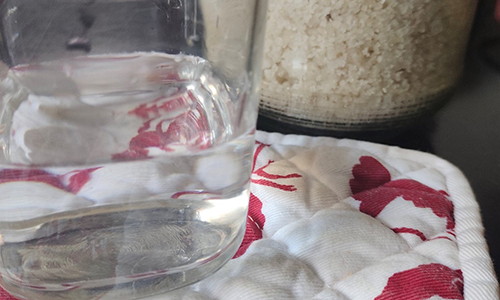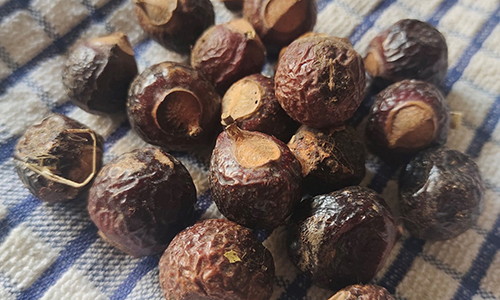Quick links: What are Soap Nuts? | Soap Nuts for Laundry | Soap Nuts for Hair/Shampoo
WHAT ARE SOAP NUTS?
Soap nuts, or Indian soap berries, have become increasingly popular in recent years for a variety of reasons. They are an amazing natural detergent due to anatural cleaning essence that is contained in their shell.
Although they have received a lot of love and attention in the last couple of years, soapnuts have been known and used for centuries: these soap berries have historically always been an integral element of Indian customs and used widely by many Indian households. They are the fruits of a small tree called Sapindus Mukorossi tree, native of the Himalayas and the mountainous region between India and Nepal. Also called soapberry nut husks, they are indeed the husk (shell) from soapberry nuts. Once picked and left to dry in the sun, these amazing shells contain a natural cleaning agent called saponin that produces an effect comparable to soap.
Want to buy soap nuts? Click here.

The great thing about saponin is that it is a 100% organic substitute to chemically made laundry and cleaning products, among others. The best thing is that it can be a substitute for many synthetic cleaning products made with SLS (Sodium Laureth Sulphates) without all the nasty drawbacks of these chemical components.
WHY ARE SOAP NUTS ECO-FRIENDLY?
TheSapindus tree grows in a wild environment, mainly in the Himalayan foothills between India and Nepal. One of its main characteristics is that it doesn’t need fertile soil to flourish, quite the opposite, and as it grows in hard environmental conditions it also protects its native areas from the risk of erosion. It is incredibly resilient to diseases and doesn’t need any fertilizer or chemical pesticides.

Its fruits, the soapberry nuts, are harvested by local populations and they provide a great source of financial sustainment for local communities, that pick up the berries after they become gooey and red as they ripen and fall to the ground.
The seed is removed from the shell and let it to dry in the sun without any chemical or synthetic agents, so soap nuts are not treated in any way and what is then put on the market is a 100% natural, un-modified product.
WHO ARE SOAP NUTS RECOMMENDED TO?
I first discovered soap nuts because my daughter developed eczema as a baby, she had food allergies and chemical laundry detergents seemed to make her flare-ups a lot worse. We tried to swap to non-bio detergents first, but that didn’t help, so out of desperation, I started researching the internet for a solution. There I stumbled on a group for eczema and other skin condition sufferers, and lots of people recommended using these Indian soap berries instead of traditional washing powders. I thought “I really have got nothing to lose” and bought my first bag of soapnuts from an eco-shop online.
The results were truly incredible, as soon as I started washing her clothes and sheets with the soap berries, her itching got incredibly better, she stopped scratching herself as much, which used to lead to infections and open wounds and she didn’t find fabric as irritating as before. That was definitely also because of other changes we brought into our lifestyle as a family, from dietary changes to using natural soaps, shampoos and other products, but I am very confident that using Indian berries for laundry had a significant part in it too.
We stock soap nuts in both 500g and 1kg refill bags.

This is because soap nuts, along with saponin, are also rich in fatty acids (EFAs).
This special composition is particularly effective in treating the following conditions:
– skin conditions such aseczema, psoriasis and rashes due to allergic reactions (due to its allergy-free, anti-fungal and antibacterial nature). We also have other natural soap for sensitive skin here.
– dry skin
– mature and ageing skin due to the anti-ageing and anti-oxidant effect
– delicate skin, particularly for babies and toddlers
– acne-prone skin, as it dries up excess oil in the epidermis and reduces the appearance of clogged pores
Interested in other natural soaps? Click here
WHAT CAN YOU USE SOAPNUTS FOR?
The Sapindus mukorossi nuts produce important amounts of a saponifying agent that can be used as laundry detergent, dish and hand soap, shampoo and body wash, pet cleaning wash and mosquito repellent among others.
HOW TO USE SOAPNUTS
The best thing about soapnuts is that a basic soapnut liquid can become the basis for many recipes, I have tried to put together all the knowledge I have acquired throughout the years to put them all together in a complete guide of soapnut recipes! Hope you’ll find it as useful as we did!
Here’s the main recipe you will need for most of the other ones:
– SOAPNUT LIQUID CONCENTRATE

- Place 4-6 crushed, deseeded soapnuts with 2 cups of water in a pot.
- Bring to boil, turn down the flame and let it simmer for 20- 30 minutes.
- Strain the liquid, put the soap nuts to dry (they can be reused to make more soap liquid) and once cold pour the soapnut concentrate in a bottle.
- Keep in the fridge for up to a week
– SOAPNUTS FOR LAUNDRY
-
Loose soapberry shells
- All you need is about 4-8 deseeded soapnut shells.
- Put them into a muslin bag, a sock or a washing net (you can even use a thin cotton cloth, put them in the middle and then use some twine around the top to secure the nuts inside).
- Place the soapnuts into the washing machine drummer and select your desired setting.
- When the washing cycle is over, take your soapnuts out of the bag and leave them in an aired place to dry before you use them again.
- You can reuse the same soapnuts 3-4 times before you add them to your compost.

-
Liquid laundry soapnut soap
You can also use soap berry shells to make a liquid washing detergent. For this you will need to make a soapnut liquid concentrate
- Dilute soapnut liquid concentrate with water
- Use a few tablespoons (depending on load size) to your washing machine detergent drawer
-
Soapnut laundry powder
Another way to use soapnuts to wash your laundry naturally is to blend them into a powder and use them as you would with a normal washing powder!
- Grab a handful of soapnuts and place them in a blender (we recommend doing this in small quantity to keep the powder fresh and not leave it unused for too long, to get the most out of its cleaning agents)
- Blend the soapnuts at a high speed until they are crushed into a fine, nutty smelling powder.
- Use 2-3 tablespoons to add to your detergent drawer in the same way you would with a normal supermarket laundry powder. If you are using cold water for your wash, we recommend mixing the powder with some boiling water first to kick start the saponin release, and use the liquid instead.
- If you have any spare powder left, put it into a sealed glass jar and keep in the fridge.

– SOAPNUTS FOR BEAUTY
-
Soapnut shampoo
- 5/6 soapnuts
- 2 cups of water
- 2/3 drops of essential oils (optional, if you suffer of skin problems or allergies I’d recommend keeping this lotion unscented)
Place soap nuts in a muslin bag or loose in a pan. Add 2 cups of water and bring to boil. Turn down heat and let it simmer for 30 minutes. Let it cool while keeping the soapnuts in the water. Pour a small amount onto wet hair and massage gently but deeply, making sure to cover the whole surface of your scalp hair. Keep in place for 5-6 minutes, then rinse carefully with warm water minutes for it to be absorbed. Rinse well with lukewarm water.
For those suffering with eczema, psoriasis or other skin condition, this lotion can also be used to soothe and nourish dry and angry skin. Please make sure not to add any essential oils if you suffer from any skin condition.
You can shop other natural shampoo here
-
Soapnuts for handwash
You can make a very quick and natural handwash by just using 2 ingredients
- 1 cup of castile soap liquid (you can make your own with solid castile soap by melting some with a bain-marie method) together with
- 1 cup basic soapnut liquid (see soapnut liquid concentrate that we previously made to prepare laundry liquid),
Mix ingredients well and store in a glass jar or even better a pump bottle. This soap is particularly good for children as they find it easier to use than soap bars. Suitable for any skin type.
You can add 2/3 drops of essential oils of your favourite aroma, however, we would recommend keeping it unscented if you have dry/damaged skin.
You could also try some natural soap on a rope.
-
Soapnut Shaving Cream
- Flesh from 15 Soap Nuts, used after being boiled to make basic soapnut liquid
- 1 tablespoon Extra Virgin Olive Oil
- 3 teaspoons Soap Nuts Liquid Concentrate
Remove the soapnuts after making soapnut basic liquid, remove the hulls as well as any harder bits of soap nuts flesh, put them into a blender and mix into a paste, and the olive oil and liquid. You will obtain a nice paste that will start to foam. Use immediately to shave after making it!

– SOAPNUTS IN THE KITCHEN AND AT HOME
1. All-Purpose Soapnut Cleaner
- 1 cup basic soapnut liquid
- 2 cup water
- 2 tbs white vinegar
- tea tree essential oil optional.
- Mix all ingredients together Store it into a spray bottle and use it to clean counters, tables, toilets and much more!
-
Diswasher Powder
- 4/5 finely grounded soapnut shells
- 2 tablespoon of grated castile soap
- 1 cup of baking soda
Mix well and add to your dishwasher in the tablet drawer, pr place in a cotton muslin bag at the bottom of your machine. We recommend using some white vinegar as rinse too!
-
Dishwashing Liquid
- 1 cup Basic Soapnut Liquid
- 7-8 drops of tea tree or eucalyptus essential oil
Mix ingredients and keep in a glass jar, use to wash dishes together with a compostable dish brush.
-
Other uses for your soapnuts
- Soapnut liquid diluted with water (1 part soapnuts, 2 parts water)
This can be used for a wide variety of uses such as
- PET WAS
- NATURAL PESTICIDE FOR PLANTS
- MOSQUITO REPELLENT
- GENTLE BODY WASH

– FAQ:
What’s the best number of soapnuts to use per wash?
It really depends on how dirty your clothes are and how big the load is. Hard water areas may require more saponin, therefore more soapnuts. I would recommend 3-4 soapnuts for half a load, especially if your washing machine is fairly new. If you live in an area with hard water or you are washing a big quantity of things, 5-6 soapnuts are definitely best to get things clean properly.
Can I reuse the soapnuts for more than one load?
Absolutely! That’s why they are such great eco-product! You can reuse the same soapnuts for 3-4 washing loads before you add them to your compost.
However, keep in mind that if you are washing clothes in very hot water, this will make the soap nuts release their cleaning agent, saponin, a lot faster, therefore their cleaning power will decrease after a few uses.
If instead, you choose to wash your things in cold water, this will make your soapnuts last longer. However, if you have very dirty items, I’d recommend putting the soapnuts in a cup and pour some boiling water on top of them beforehand. That will kickstart the release of their natural surfactants and allow a much better cleaning performance. Remember to add the soapy water to your wash too!
Once all the saponin is released from the shells, the soapnuts will stop feeling sticky and will start looking quite pale and brittle once dry. When that happens, it’s time to say goodbye, pop them in your composting pile and start using a new fresh handful.
Can I use loose soapnuts to hand wash clothes?
Yes, of course! Just add a handful of crushed shells into a washing tub together with the items you need to wash. Run hot water over them, or if you prefer to use cold water, make sure you soak your soapnuts in a cup of boiling water before pouring both the liquid and the shells into the tub. This laundry system is particularly recommended for delicate fabrics, such as silk and wool, or garments that would release dye in the washing machine and therefore need to be washed separately.
Will soapnuts get rid of stains on bedding, stuffed toys, children’s nappies or bet bedding?
Soapnuts are particularly recommended for babies clothes and items, as they are 100% chemical-free and allergy-free, perfect for the delicate skins of infants and young children. They are also great at killing bacteria, so they can be used to wash your pets and their own things too!
Hope you are all nutty for soapnuts now! If you have any other special soapnut recipes , let us know in the comments!
















